INTRODUCTION
In many countries, rice contributes to health by supplying dietary energy, protein and fat.1,2 The rice bran was originally known to have a rich amount of vitamins and minerals. In addition, various functional substances such as γ-oryzanol, sterols and phytic acid, etc. are included. The influence of brown rice on health is extremely large, so it could be called “medical rice” for keeping health and preventing various diseases.3
According to our research, macrobiotic practitioners consumed more magnesium, iron, vitamin E, vitamin Bs and dietary fiber although their energy intake was less than that of average Japanese.4 Their Body Mass Index (BMI), blood pressure and lowdensity lipoprotein (LDL) cholesterol levels were mostly found to be low, and HbA1c revealed within normal levels.4,5 The macrobiotic dietary pattern of eating brown rice seemed to contribute to their healthy state.
Recently much attention has been paid to rice bran, because the ingredients of rice bran show various interesting properties, like anti-oxidation.6 Recent study further clarified many functional ingredients in the rice oil.7 It is separated to gum, wax, dark oil and scum, and each fraction contained a number of chemicals. Brown rice is made up of three concentric layers, respectively: (i) the outer layer of the endosperm (starch storage cell layer), (ii) the aleurone layer and (iii) the bran layer. Removing the bran layer makes the rice tastier.8 Proteins, vitamins, and other functional nutrients are mostly present in the bran layer. They are covered by an extremely hard wax layer.
The health benefits of brown rice are well-known, but consumers prefer polished white rice. Brown rice does not become popular, due to its hardness for mastication, and some felt gastric distress. In Japan, soft textures, such as the fast food, are preferred recently by young generation. The wax layer of brown rice disturbs immersion of water when boiling. So, Keiji Saika elaborated to invent the new rice processing machine to remove only surface wax layer (Figure 1).
Figure 1. Wax Layer of the Brown Rice and Wax Removal
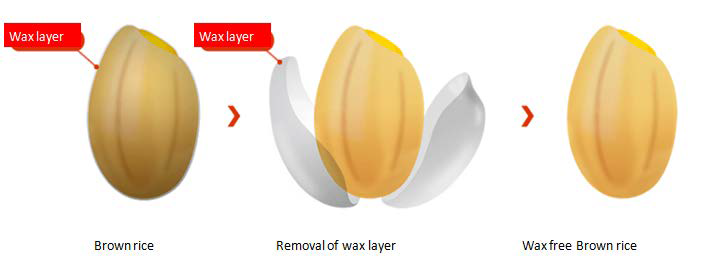
A low-protein diet (LPD) has long been used for dietary therapy to preserve the renal function of patients with chronic kidney disease (CKD).9,10,11 However, low protein rice was made from polished white rice, so almost all nutrients except carbohydrates were lost. Protein extraction from wax free brown rice (WFBR) was also succeeded by Forica Group. Nutritional aspects of this rice in comparison with other processed rice is dealt with in this paper.
The above rice was candidates of medical rice, so precise characterization was necessary.
MATERIALS AND METHODS
The Food Composition Table 2015 precisely described the data of rice, but these are data of raw rice, and their corresponding boiled rice data were calculated by multiplying 2.2 as a cooking water.11 To know the true amount of nutrients in boiled rice should be directly prepared for the measurement.
To know the changes of nutrients by specific rice processing, the same brown rice was used for different processing method; i.e. removal of wax layer (WFBR), low protein rice of wax free brown rice (LPBR), half polished brown rice, kinme polished white rice, and bran grind (BG) rinse free white rice. Kinme polishing process remained aponeuronic layer for better taste.
The “bran grind method” (BG method) as an alternative method of rice processing avoiding the use of water.8 To make rinse-free rice, the viscosity of bran itself is used to remove “skin bran.” Kinme polishing remained aponeurotic layer for saving amino acids, because the endosperm surface is important to keep the taste by free amino acids.
The LPBR used proteolytic enzymes to digest and remove the protein in WFBR.9 As proteolytic enzyme, acidic protease approved by the Ministry of Health, Labour and Welfare (MHLW) as a food additive and available on the market was used. In our method, an enzyme mix (EM) consisting of Aspergillus oryzae, Rhizopus niveus, and Aspergillus niger was used. The main component was protease in the aspartic protease family (EC 3.4.23).
The raw LPBR was spread out evenly into a thickness of 30 to 50 mm, then steamed for 4 to 10 minutes using superheated steam of at least 105 °C. Immediately after steaming, the steamed LPBR was separated loosely and dried by warm air so that the moisture level was uniform throughout, at 16% to 20%. It was the continuous production conveyor-system.
The processed 1.0 kg rice grain by a stepwise method was boiled by the pressure induction heating (IH) rice cooker (Tiger JPC-A), according to the instruction. The boiled and immediately frozen rice was sent to the SUNATEC Research Laboratories to measure the following; major nutrients (carbohydrate, protein, saturated and unsaturated fatty acids and neutral fat, ash, water soluble and insoluble dietary fibers), micronutrients (vitamins A, B1, B2, B6, B12, C, D, K, niacin, panthotenic acid folic acid, biotin), minerals (calcium, phosphate, iron, natrium, potassium, magnesium, zinc, copper, selenium, manganate), 28 amino acids and GABA, γoryzanol and antioxidants (AOU-L and AOU-P).13 γ oryzanol was measured at the Tsuno Food Industrial Laboratory. For an ORAC measurement, 6-hydroxy-2,5,7,8-tetramethylchroman- 2-carboxylic acid (Trolox) was used as a standard antioxidant, and the antioxidant capacity of the sample was expressed as Trolox equivalent.14,15,16
Some measurement of LPBR was performed at the Nippon Food Analysis Center, Tokyo, Japan.17 Energy, major nutrients, vitamins, minerals and number of bacilli and heat resistant spores were measured according to the guidelines of the Ministry of Agriculture, Forest and Fishery.
All data were collected in the Excel file and transferred to SPSS file for statistical analysis.18 Comparison was made by t-test or ANOVA, and significant levels were set, as *< p=0.05, **<p=0.01, ***p=0.001.
RESULTS
Macronutrients contents are shown in Table 1. Removal of wax layer did not affect the nutritional values of brown rice. Slight reduction of energy source was caused by immersion of cooked water, which made soft palatability like white polished rice (Figure 2). Protein extracted rice showed 70% reduction of rice protein, as well as ash reduction. Dietary fibers remained in both wax removed rice, but it became half in the half polished and polished rice. Water soluble fiber seemed to be more easily solved out than insoluble dietary fiber during the processing. (Figure 3).
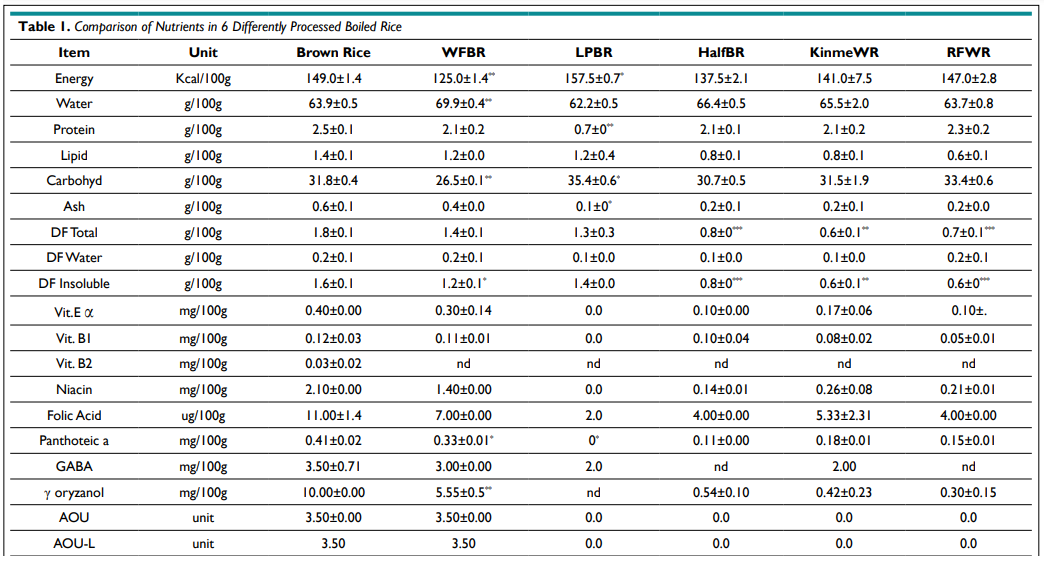
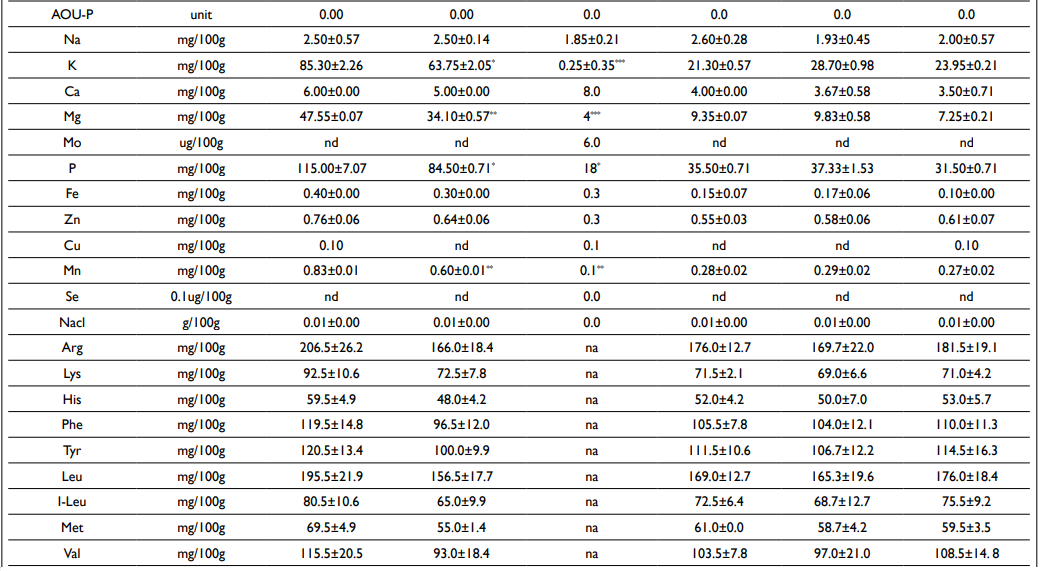

Figure 2. Raw Brown Rice (Upper Left), and Wax Free Brown Rice (Upper Right). Boiled Rice; Brown Rice, Wax Free Brown Rice, and BG Rinse-Free Rice (Lower Half). Brown Rice Particles (Left) are Smaller Compared to the White Rice (Right). Wax Free Brown Rice (Middle) Shows the Same Size of White Rice Due to Good Immersion of Water at Boiling
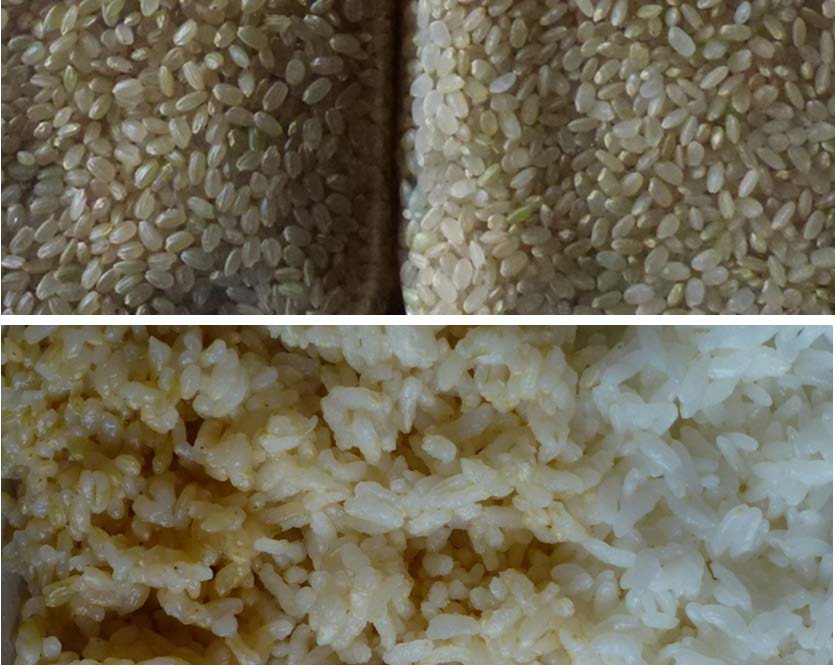
Figure 3. Comparison of Protein, Lipid, Ash and Dietary Fibers of 6 Differently Processed Rice Marked Reduction of Protein and Ash is Noticed, While the Dietary Fibers were Stored
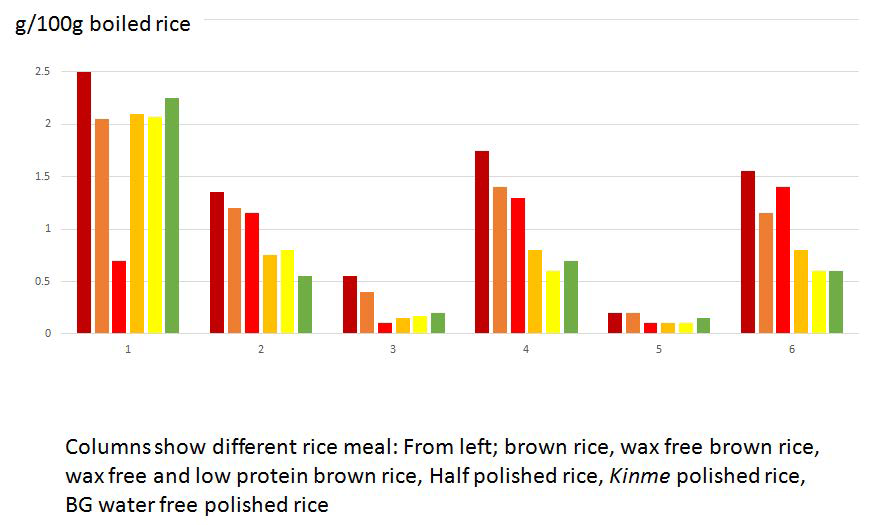
As for the micronutrients, vitamin B1 was remained almost 90% in WFBR, but vitamin E, niacin, folic acid, panthotenic acid were lost 30 to 40%. (Table 2)
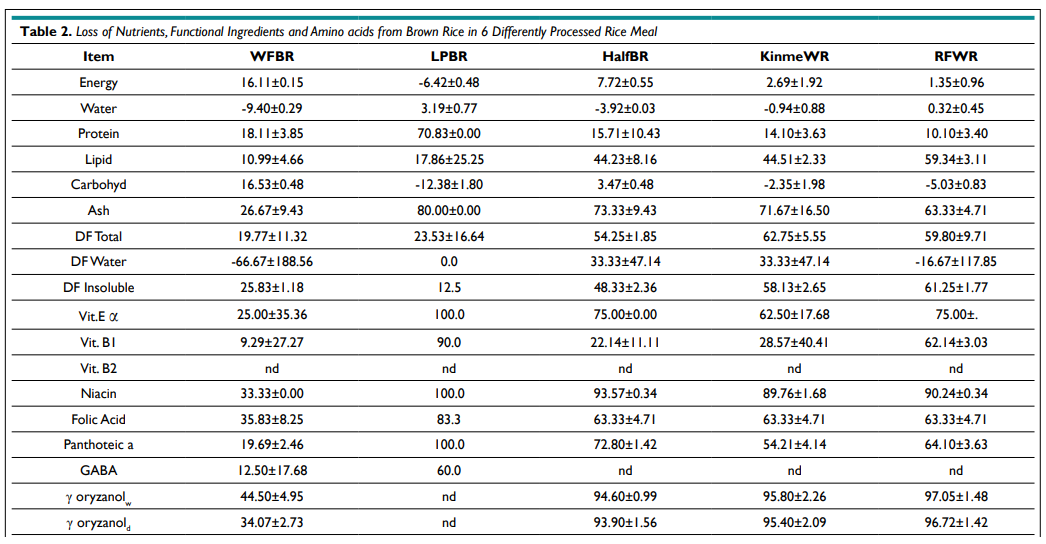
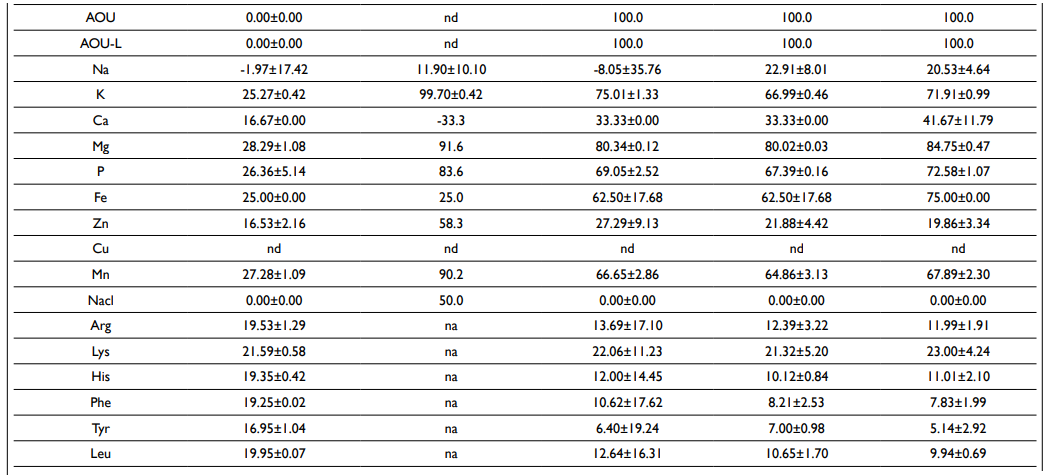
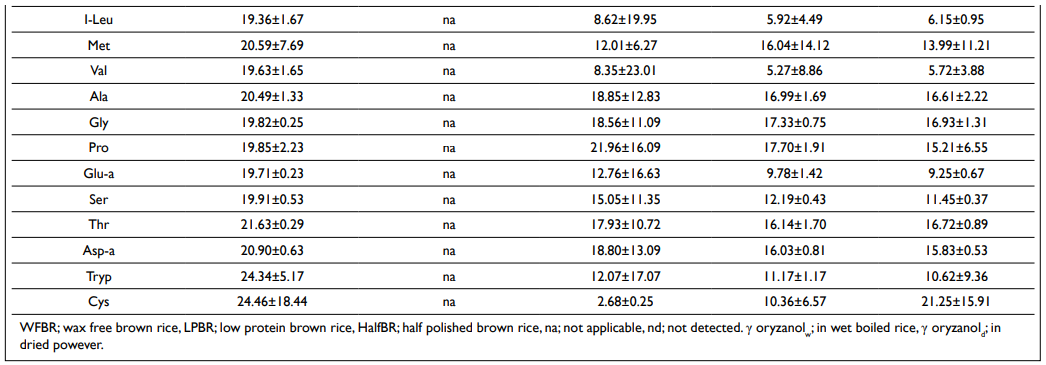
Reduction of minerals was characteristic in LPBR. The remaining minerals was only 0.3% in potassium, 8.4% in magnesium, 9.6% in manganese, 15.7% in phosphate, and 39.5% in zinc. BG rinse free white rice also showed low potassium and phosphate. WFBR broadly decreased about 20-30%. (Fig. 4).
Figure 4. Comparison of Minerals in 6 Differently Processed Rice Potassium is Completely Removed and 84% of Phosphate Decreased
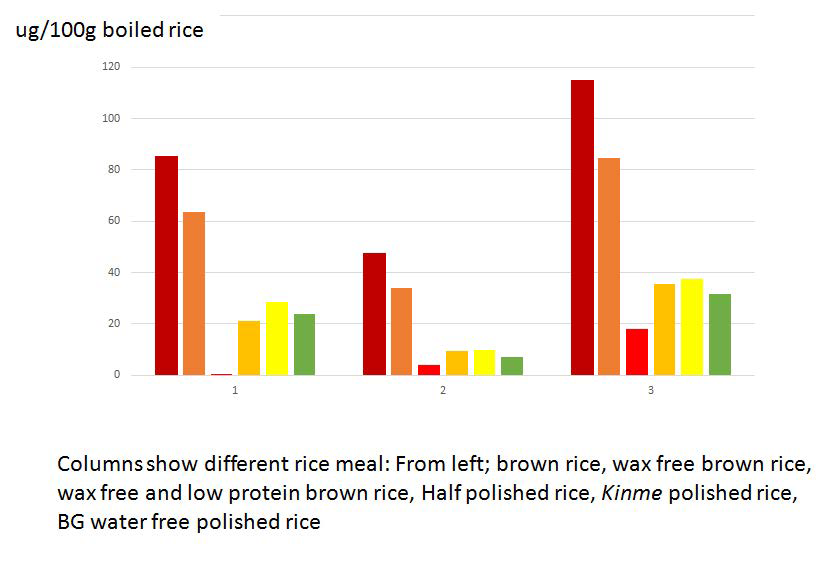
WFBR broadly reduced all 18 amino acids about 20%. Polished rice kept similar level, and BG rinse-free rice remained higher contents. Loss of amino acids was about 5% in i-leucine, valine, tyrosine, phenylalanine, and about 10% of serine, histidine and leucine.
GABA remained 85.7% of brown rice in WFBR, but decreased to half in the polished rice.
Gamma oryzanol content became half in WFBR, and remained only a few percent in the polished rice.
Antioxidant activity of both brown rice and WFBR remained 3-4 unit in the boiled rice, mostly water soluble AOU- L. Polished rice did not show antioxidant activity at all.
DISCUSSION
Whole brown rice, compared with white rice, is rich in vitamins, minerals, dietary fiber and various functional chemicals.3 The effects of eating brown rice have been gaining attention for preventing and treating not only beri-beri and constipation, but also other chronic diseases including symbiosis with enterobacteria.4,5,19,20 Rice bran is used in a variety of applications such as food, animal feed and fertilizer, but most of the rice bran is discarded at present. So, recommendation of brown rice eating is contributed to both public health concern and environmental issue.21,22,23 Genmai (brown rice) eating is beneficial to keep the proper body weight.5,20
It was said that about 1/3 brown rice (genmai) eater abundaned eating genmai. Brown rice does not become popular, due to its hardness for mastication, and some felt gastric dyspepsia.24 Removal of waxy layer succeeded by Keiji Saika to improve texture and palatability of brown rice. The nutrients and antioxidant activity were the same as brown rice after adjusting water content, so it should be a gospel to whom want to eat brown rice for health. It made it possible to use even for Sushi.
Newly made protein extracted wax free brown rice (LPBR) could be expected to have wide usage in clinical nutrition.7,11 CKD patients have a necessity to reduce phosphorus and potassium intake in addition to decrease protein intake. At the same time, there is a need to ensure the patient takes in enough nutrients, particularly energy. LPBR meets all of these requirements as a staple food for CKD patients. Additional benefits should be obtained for the disease by dietary fiber, vitamins, gamma oryzanol, ferulic acid and antioxidant activity. Almost no potassium and low phosphate in LPBR were also beneficial for the patients to prevent hyperkalemia and hyperphosphatemia.11 Recently we finished a randomized clinical trial in Bangkok by using protein extracted Indica rice, and had a report of similar effectiveness for CKD. Dietary fiber intake stimulated growth of intestinal bacteria which produce short chain fatty acids, which are beneficial for gut environment.18,19
γ-Oryzanol and GABA are thought to be effective for mental health.3,25 According to the aging society the increased number of impaired cognitive function becomes serious problem. In Japan it is estimated to be 2 million people, and WHO estimates that 47.5 million people have dementia and there are 7.7 million new cases every year worldwide.25 GABA and γ-oryzanol are involved in hypothalamic catecholamine metabolism. γ-Oryzanol is known to have anti-stress effects, palliation of menopausal disorders and dysautonomia.26 The effects on humans, improvement of hypertension, curative effect of Alzheimer’s disease, amelioration in muscular fatigue are recently reported.
Large germ brown rice and pre-germinated brown rice contain functional ingredients to prevent dementia, such as GABA, γ-oryzanol, in addition to the nutritional elements such as vitamins, minerals, and dietary fibers. Removal of wax layer could be applicable to large germ brown rice in the near future.
Many phytochemicals contain antioxidant ability which protects damages caused by the free radicals.13,14,15 An antioxidant test known as ORAC (Oxidation Radical Absorbance Capacity) has become popular by easy applicability for standardization.26,27,28 The US Department of Agriculture measured the antioxidant capacities of 326 food items, and in the case of fruits and vegetables, the ORAC values for the hydrophilic fractions (H-ORAC) were typically much higher than those of the lipophilic fractions (LORAC).
However, other multiple assay system such as, DPPH, TRAP, TEAC, etc., have been used to define the antioxidant capacity of food ingredients.26,27 Consumption of rice is about 500 g a day as a staple food in daily meals should prevent carcinogenesis and diseases caused by free radicals.29
CONCLUSION
Health effects of brown rice is empirically well known, and accumulating knowledge about the physiological and pharmacological activity of rice bran strongly support the brown rice meals, but it does not become popular in Japan. Removal of wax layer improved much of the dispute of brown rice. LPBR has many benefits for patients for renal insufficiency by decreasing protein intake, low patassium and phosphate, and functional ingredients and antioxidant activity. These are strong candidates for medical rice.
DECLARATIONS
Dr. S. Watanabe conducted this study and do not have any conflict of interest with lower companies. Ms. Azusa Hirakawa is a graduate student of Otsuma women’s University.
Mr. Keiji Saika were working for Toyo rice Co. Ltd.
Drs. Norihisa Takei and Shigeru Beppu were employee of Forica Foods Co., Ltd.
Dr. Hiroyuki Hashimoto was an employee of Tsuno Food Industrial Co. Ltd.
All study and work has been performed at the Toyo Rice Co. Ltd, Forica Food Industy Co. Ltd, and Tsuno Food Industrial Co. Ltd.















